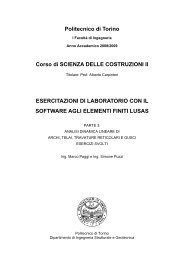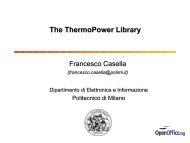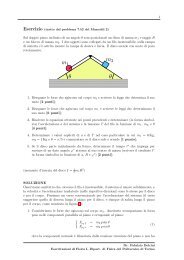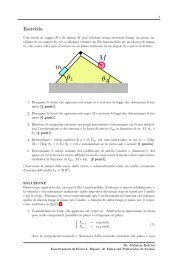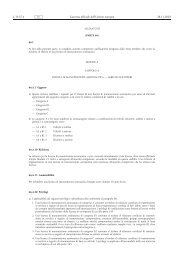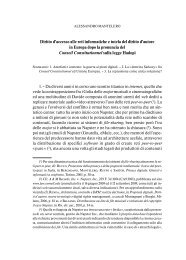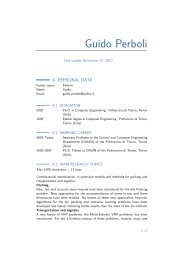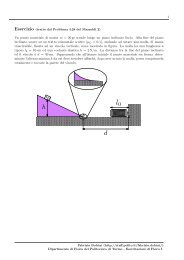The ITER toroidal field model coil project
The ITER toroidal field model coil project
The ITER toroidal field model coil project
You also want an ePaper? Increase the reach of your titles
YUMPU automatically turns print PDFs into web optimized ePapers that Google loves.
238 A. Ulbricht et al. / Fusion Engineering and Design 73 (2005) 189–327<br />
around the world and meets <strong>ITER</strong> TF <strong>coil</strong> current<br />
levels.<br />
• High voltage test equipment and a cryogenic high<br />
voltage laboratory are available for further developments<br />
of the <strong>ITER</strong> magnet dielectric insulation<br />
system.<br />
Symbols used in equations:<br />
Symbol Explanation<br />
Ei(t) Energy losses of circuit i, i =1,2,...,5<br />
I(t) 5× 1 vector of circuit currents<br />
Ii(t) Circuit current of circuit i, i =1,2,...,5<br />
L Inductance matrix (5 × 5)<br />
Pi(t) Power losses circuit i, i =1,2,...,5<br />
R Resistance matrix (5 × 5)<br />
R11 LCT <strong>coil</strong> circuit resistance (mainly Al bus bars and<br />
water cooled flexible cables)<br />
R22 LCT <strong>coil</strong> circuit resistance (mainly Al bus bars and<br />
water cooled flexible cables)<br />
Rd1 Discharge resistor circuit 1 (LCT <strong>coil</strong>)<br />
Rd2 Discharge resistor circuit 2 (TFMC)<br />
V(t) 2× 1 vector of circuit voltages<br />
Vi Circuit voltage of circuit i, i =1,2<br />
General acronyms, abbreviations, and initialisms are explained in<br />
Glossary.<br />
5. Current sharing tests and assessment of the<br />
performance/operating limits of the TFMC<br />
conductor<br />
5.1. Introduction and general properties<br />
<strong>The</strong> classical measurement of the current sharing<br />
temperature TCS on a single strand requires to operate<br />
under a constant and uniform magnetic <strong>field</strong> B, with a<br />
DC current I flowing through the wire. <strong>The</strong>n the operating<br />
temperature T is slowly increased while the voltage<br />
drop V over a given length L (preferably equal to a<br />
multiple of the strand twist pitch length) is recorded to<br />
extract an average electric <strong>field</strong> E = V/L. By definition,<br />
the current sharing temperature TCS(B, I) is the value<br />
of T for which E = Ec =10�V/m. <strong>The</strong> accuracy of this<br />
measurement relies on the uniformity of B, T and other<br />
determining parameters (such as the strain in Nb3Sn<br />
strands), over the length L.<br />
<strong>The</strong> measurement of the current sharing temperature<br />
on a multistrand twisted cable as a whole should follow<br />
the same rules, except the length L is a multiple of the<br />
last cabling twist pitch length. However, the comparison<br />
of the cable performance with the original strand<br />
one turns out to be rather complex because of all the<br />
heterogeneities encountered by the strands inside the<br />
cable. One major source of non-uniformity is the magnetic<br />
<strong>field</strong> gradient in the cable cross-section due to the<br />
so-called self-<strong>field</strong> (which can be generally neglected<br />
in the case of the single strand), but other sources<br />
exist such as non-uniformities of temperature (at least<br />
along the cable in the case of a cable-in-conduit), strain<br />
(for Nb3Sn strands), current distribution among strands<br />
(depending on the joints), and angle between strand<br />
and magnetic <strong>field</strong> (depending on the cabling pattern)<br />
[69]. In a general way, for Nb3Sn cables, the comparison<br />
leads to estimate the strain state of the filaments in<br />
the conductor [70,71], however it can be easily understood<br />
that this final result will depend on the level of<br />
<strong>model</strong>ling of all the heterogeneities in the cable, and<br />
that the use of refined computer codes becomes rapidly<br />
compulsory.<br />
<strong>The</strong> measurement of the current sharing temperature<br />
in the TFMC still reached a higher level of<br />
complexity. First from an intrinsic point of view,<br />
because of the evolutions of <strong>field</strong>, temperature, and<br />
strain along the conductor length, and second from<br />
a practical point of view, because only the overall<br />
voltage drop across one full pancake (including the<br />
joints) and the helium inlet temperature were measured<br />
[72].<br />
<strong>The</strong> tested pancake was the P1.2 pancake, which<br />
is located close to the LCT <strong>coil</strong>. This pancake is submitted<br />
to the maximum magnetic <strong>field</strong> when the LCT<br />
<strong>coil</strong> current is set at 16 kA. Fig. 5.1 gives the distributions<br />
along the pancake length (1st inner turn) of the<br />
maximum magnetic <strong>field</strong> modulus Bmax, the magnetic<br />
<strong>field</strong> on conductor center Bcenter [73], and the applied<br />
longitudinal strain on the conductor (called operating<br />
strain εop) [74] (see also Section 8.4), for 80 kA in the<br />
TFMC and 0 kA in the LCT <strong>coil</strong>. <strong>The</strong> same distributions<br />
are plotted in Fig. 5.2 for 80 kA in the TFMC<br />
and 16 kA in the LCT <strong>coil</strong>. <strong>The</strong> abscissa origins in<br />
Figs. 5.1 and 5.2 correspond to the beginning of the<br />
inner joint, which is therefore fully included in the<br />
curve. It can be seen that the peak <strong>field</strong> is not far from<br />
the inner joint (about 1.6 and 2.0 m from the center of<br />
the joint in Figs. 5.1 and 5.2, respectively).<br />
Looking first at Fig. 5.1, one can see a significant<br />
but almost constant transverse <strong>field</strong> variation



